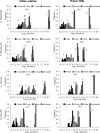Analysis of the variability in the number of viable bacteria after mild heat treatment of food
- PMID: 19801476
- PMCID: PMC2786536
- DOI: 10.1128/AEM.00452-09
Analysis of the variability in the number of viable bacteria after mild heat treatment of food
Abstract
Variability in the numbers of bacteria remaining in saline solution and whole milk following mild heat treatment has been studied with Listeria innocua, Enterococcus faecalis, Salmonella enterica serovar Enteritidis, and Pseudomonas fluorescens. As expected, the most heat-resistant bacterium was E. faecalis, while P. fluorescens was the least heat resistant, and all bacteria showed greater thermal resistance in whole milk than in saline solution. Despite the differences in the inactivation kinetics of these bacteria in different media, the variability in the final number of bacteria was affected neither by the species nor by the heating substrate, but it did depend on the intensity of the heat treatment. The more severe the heat treatment was, the lower the average number of surviving bacteria but the greater the variability. Our results indicated that the inactivation times for the cells within a population are not identically distributed random variables and that, therefore, the population includes subpopulations of cells with different distributions for the heat resistance parameters. A linear relationship between the variability of the log of the final bacterial concentration and the logarithmic reduction in the size of the bacterial population was found.
Figures



References
-
- Augustin, J. C., V. Carlier, and J. Rozier. 1998. Mathematical modelling of the heat resistance of Listeria monocytogenes. J. Appl. Microbiol. 84:185-191. - PubMed
-
- BACANOVA Consortium. 2005. Final report on the European project QLRT-2000-01145: optimisation of safe food processing methods based on accurate characterisation of bacterial lag time using analysis of variance techniques (BACANOVA). European Commission, Brussels, Belgium.
-
- Barker, G. C., P. K. Malakar, and M. W. Peck. 2005. Germination and growth from spores: variability and uncertainty in the assessment of food borne hazards. Int. J. Food Microbiol. 100:67-76. - PubMed
-
- Cabeza, M. C., J. A. Ordóñez, M. I. Cambero, L. de la Hoz, and M. L. García. 2004. Effect of thermoultrasonication on Salmonella enterica serovar Enteritidis in distilled water and intact shell eggs. J. Food Prot. 67:1886-1891. - PubMed
-
- Chaudhary, R. A., S. L. Tuckey, and L. D. Witter. 1960. Heat resistance of three strains of psychrotrophilic organisms added to skim milk for cottage cheese manufacture. J. Dairy Sci. 43:1174-1182.
Publication types
MeSH terms
Substances
Grants and funding
LinkOut - more resources
Full Text Sources
Molecular Biology Databases
Research Materials

